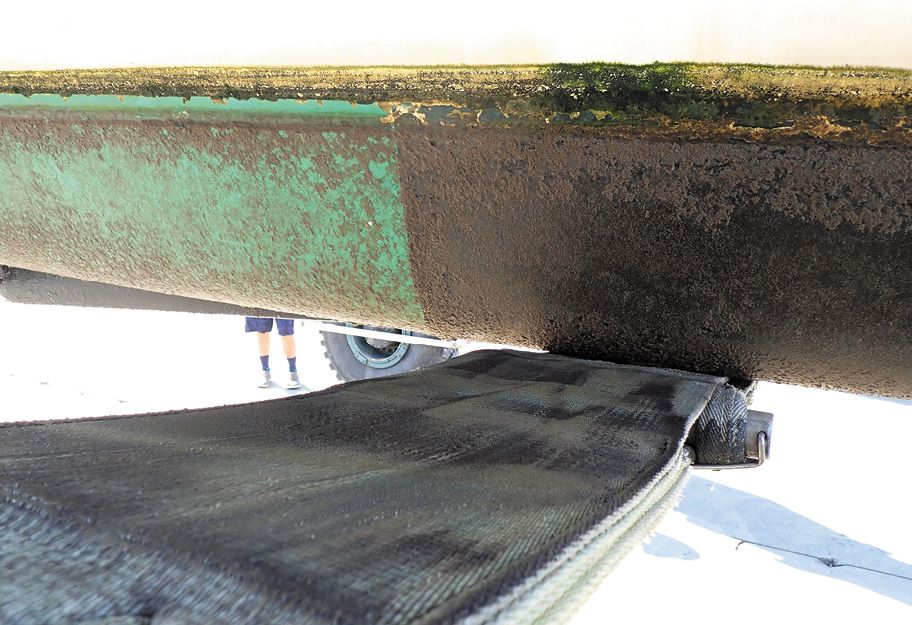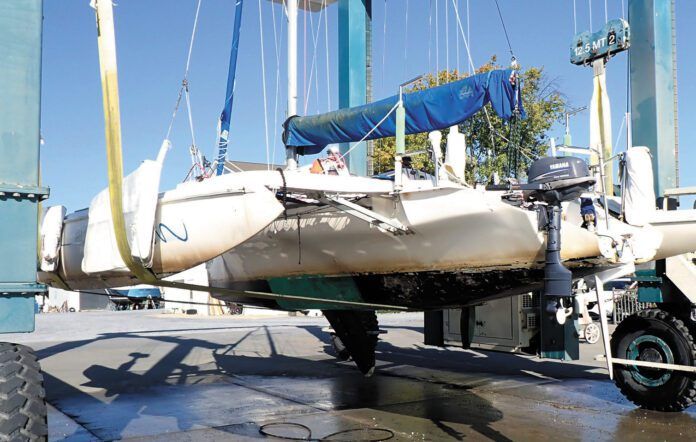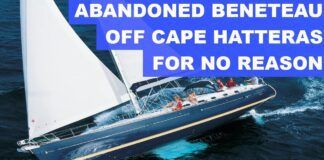In addition to our panel testing of dozens of paints, we applied six different antifouling paints to our test boat, a Corsair F-24 trimaran. The center hull and the two amas were divided up. We applied two coats to all areas, with an extra coat in high wear areas (the bow and sides). We put three coats on the centerboard and a single coat inside the case.
We attempted to give each paint equal exposure to sunlight, but we could not fully control this variable. In terms of relative rankings among paints in the same category (hard and soft), there were no significant differences other than what we saw in the panel testing, which provided an even playing field.
We sailed the boat about two or three times per month for 4 to 8 hours during each session, typically at speeds of 6 to 10 knots, but occasionally as fast as 15 knots on windy days. We inspected the boat in the water every six months. We gave it a light cleaning after 14 months with the Davis Scrubis (see “Scrubis Defies Skeptics,” PS December 2021), and a more energetic scrub while snorkeling at 20 months. The haulout four months later offered a closer look at the results.
IN-WATER HULL OBSERVATIONS AT 20 MONTHS
Before cleaning, we went for a vigorous half-day sail, across Chesapeake Bay and back. This was to remove any lightly adhered soft growth.
Pettit Trinidad Pro. Applied to the bow, front third of main hull, Trinidad Pro was covered in thin soft growth, with just a few immature barnacles. All fouling could be wiped off with a glove. There was no need for scraping.
Pettit Odyssey Triton. Pettit’s most expensive ablative, Triton scored Good in panel testing at 24 months. At 20 months on the boat, it was free of any significant fouling. It was applied to the centerboard, which is retracted when the boat is stationary in its slip. This can reduce fouling by limiting exposure to sunlight and oxygen, and perhaps by concentrating antifouling agents in a confined space. However, paint on the centerboard can wear away faster, especially along the leading edge. We anti-foul the inside of the centerboard case only every 4 years to reduce paint build up in an area, which is agonizing to sand. This has been enough to keep the inside of the case clean.
On boats with a tight-fitting centerboard, you may want to paint the hinge area with just one coat to prevent the board from getting stuck in the centerboard trunk.
Total Boat Krypton. Applied near the middle of the main hull, this was a top performer on the boat, with only traces of thin, soft growth and a few barnacles. This paint also performed the best at the waterline, where fouling is generally the most extensive. A gentle wipe with an extremely worn out red Starbrite pad made the paint bright green again. Despite lacking copper, and having a relatively small amount of zinc biocide, this paint performed exceptionally well.
Interlux Micron CSC. Applied to the aft third of the main hull, the ablative paint Micron CSC lost its effectiveness at 24 months. This is typical for this paint, which we’ve used before in this location. In several places there was very heavy growth, including large patches of solid barnacle growth that required vigorous scraping. About half of the test area showed heavy soft growth, creating ¾-inch thick carpet. Some areas were lighter and could be wiped off.
ePaint ZO. Painted to the starboard ama, the copper-free ZO had clearly lost its antifouling properties after the first year. (In panel testing it rated Excellent during the first year, but it had lost its potency after two years.) This is a photo-active paint that delivers better protection in sunlight. At the two-year mark, the area on the inside of the float with less sun exposure required heavy scraping to remove barnacles. The outside of the hull that had more sun exposure required less scraping, but the paint also had considerable hard growth and had effectively failed. In some areas the growth was 1-¼ inches thick. We also had adhesion problems. Although we’ve not experienced this in panel testing, it is not surprising that this happened on the test boat since preparing a previously painted hull for this paint requires more prep work than usual.

ePaint Ecominder. Painted on the port ama, the metal-free Ecominder paint had lost its antifouling properties after the first year. It protected a little better than ePaint ZO; there was more soft growth, but less hard growth. The paint started peeling along the waterline after about six months. As with the ZO paint, this could be attributed to the added challenges associated with over-coating a previously painted hull.
OBSERVATIONS AT 24-MONTH HAUL OUT
The hull was inspected before and after power washing. We hauled out in the fall and the Chesapeake Bay water had not yet cooled appreciably (74 F). Marine growth was still very active. In our test waters, the water drops below 50 F and growth slows markedly. When the water is near freezing, some growth will actually release and fall away. Mid-summer water temperatures average in the low 80s.
Pettit Trinidad Pro. Trinidad Pro showed only a little growth near the waterline. Power washing did not damage this durable hard paint, proving its scrub-resistant reputation. A quick wipe with a Starbite pad, using the hard edge to pop off a few barnacles, would have cleaned the hull. Trinidad hard paints all performed predictably well, with the advantage of easy scrubbing, although they are probably best suited to boats that are either sailed frequently and vigorously, or serviced by a diver. (Note that some of the marinas in our test area do not permit diver cleaning of boats.)
Pettit Odyssey Triton. Applied to the centerboard, this ablative paint remained very clean, with just a few small barnacles. This centerboard is the lowest fouling location on the boat. However, if you want to use a bargain paint, buy a little of the good stuff for the foils (keel and rudder), where growth will critically affect windward performance. We will do more boat testing with this paint in Florida.
Total Boat Krypton. Krypton performance dropped sharply on the panel testing after 20 months, but it remained the number two performer on the boat. It seemed a little slicker than other ablatives, perhaps allowing it to shed growth underway, and it seemed to be of intermediate hardness, tolerating cleaning a little better than other ablatives. Like Trinidad Pro, we could have wiped away the growth with a Starbrite pad. An ablative won’t hold up to regular, vigorous cleaning as well as a hard paint, but it won’t build up. After a moderate sanding, much of the last paint was peeking through.
Interlux Micron CSC. Micron CSC was no longer effective against barnacles after the 20-month scrub. Soft growth was also widespread. This mirrors with our prior on-boat experience with this paint in this area. One popular feature of this paint, and one we’ve confirmed previously on our test boats, is that it will retain its effectiveness through a winter haulout, unlike hard paints, which need to be reactivated by sanding. We are uncertain how this trait compares with other ablatives.
ePaint ZO. As mentioned, ePaint ZO lost its antifouling properties at the one-year mark. The adhesion problems got worse through year two.
ePaint Ecominder. The antifouling paint also failed earlier in the cycle, at about the one-year mark. After two years the adhesion problems were severe, with about 20 percent of the paint coming off during power washing. Complete removal, required for repainting, was not all that difficult because the adhesion was poor.
CONCLUSION
The best ablatives edged out the best hard paints in panel testing, but the lone hard paint that we tested on the boat topped the “real-world” field. If we weren’t recoating, we would anticipate the harder paints to pull ahead in the next year, as more scrubbing would be necessary. But with our two-year haul-out regimen, the advantage of having an ablative paint was clear. By the time we scrubbed, power-washed, and lightly sanded the ablative coatings, only about 30 percent of the original paints remained and the surface was ready for recoating. If we followed the two-year service plan with a hard paint we’d have a reckoning after 5-7 haulouts, when we’d need to remove all the paint.
With the test over, we were looking forward to having a hull with just one paint on it. With several good options from the test field, it wasn’t an easy choice.
We like how well the Trinidad hard paints stand up to scrubbing. The reduced build-up in the Odyssey ablative paints is a bonus, and the Triton was virtually spotless. In the end, we decided to paint the Chesapeake Bay boat with Total Boat Krypton. During most of the 2-year test, this was the best overall performer and it had a harder job than the Pettit Triton, which saw less exposure in the centerboard trunk. We also see it as an opportunity for an extended experiment. We’ll be painting Triton on a Florida test boat docked at a marina known for its heavy fouling to see how it does.
If you have some experience with any of these test paints or other paints on your own boat, we’d be interested in hearing from you. Please email us at [email protected].




































